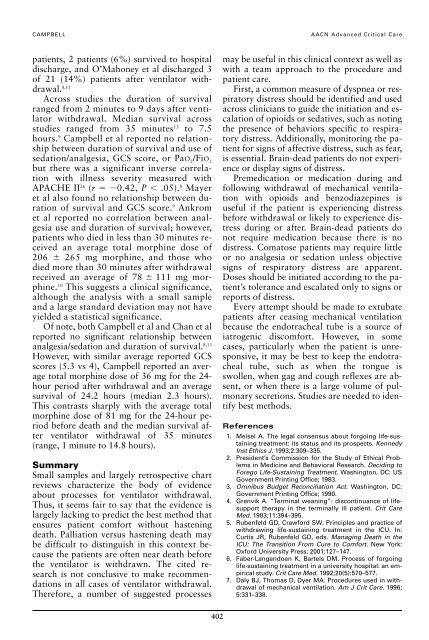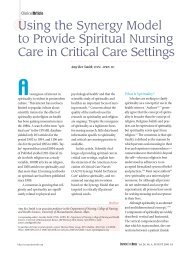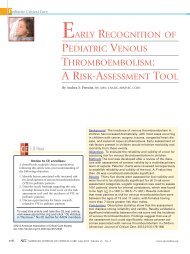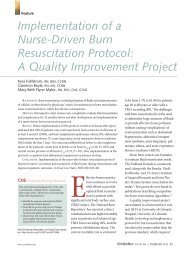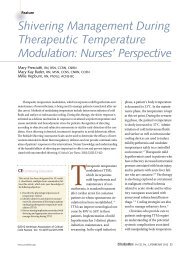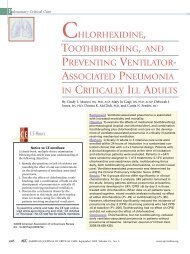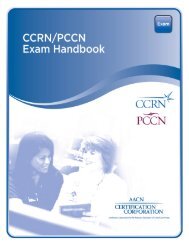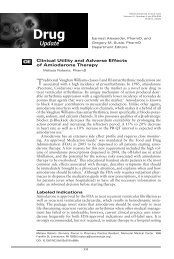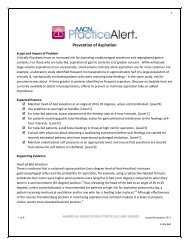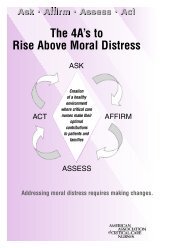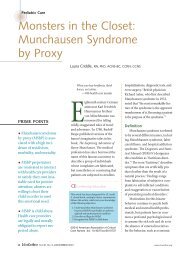How to Withdraw Mechanical Ventilation - American Association of ...
How to Withdraw Mechanical Ventilation - American Association of ...
How to Withdraw Mechanical Ventilation - American Association of ...
You also want an ePaper? Increase the reach of your titles
YUMPU automatically turns print PDFs into web optimized ePapers that Google loves.
AACN18_4_397-403 10/20/07 14:23 Page 402<br />
CAMPBELL AACN Advanced Critical Care<br />
patients, 2 patients (6%) survived <strong>to</strong> hospital<br />
discharge, and O’Mahoney et al discharged 3<br />
<strong>of</strong> 21 (14%) patients after ventila<strong>to</strong>r withdrawal.<br />
8,11<br />
Across studies the duration <strong>of</strong> survival<br />
ranged from 2 minutes <strong>to</strong> 9 days after ventila<strong>to</strong>r<br />
withdrawal. Median survival across<br />
studies ranged from 35 minutes 13 <strong>to</strong> 7.5<br />
hours. 9 Campbell et al reported no relationship<br />
between duration <strong>of</strong> survival and use <strong>of</strong><br />
sedation/analgesia, GCS score, or PaO 2/FiO 2<br />
but there was a significant inverse correlation<br />
with illness severity measured with<br />
APACHE II 26 (r ��0.42, P � .05). 8 Mayer<br />
et al also found no relationship between duration<br />
<strong>of</strong> survival and GCS score. 9 Ankrom<br />
et al reported no correlation between analgesia<br />
use and duration <strong>of</strong> survival; however,<br />
patients who died in less than 30 minutes received<br />
an average <strong>to</strong>tal morphine dose <strong>of</strong><br />
206 � 265 mg morphine, and those who<br />
died more than 30 minutes after withdrawal<br />
received an average <strong>of</strong> 78 � 111 mg morphine.<br />
10 This suggests a clinical significance,<br />
although the analysis with a small sample<br />
and a large standard deviation may not have<br />
yielded a statistical significance.<br />
Of note, both Campbell et al and Chan et al<br />
reported no significant relationship between<br />
analgesia/sedation and duration <strong>of</strong> survival. 8,13<br />
<strong>How</strong>ever, with similar average reported GCS<br />
scores (5.3 vs 4), Campbell reported an average<br />
<strong>to</strong>tal morphine dose <strong>of</strong> 36 mg for the 24hour<br />
period after withdrawal and an average<br />
survival <strong>of</strong> 24.2 hours (median 2.3 hours).<br />
This contrasts sharply with the average <strong>to</strong>tal<br />
morphine dose <strong>of</strong> 81 mg for the 24-hour period<br />
before death and the median survival after<br />
ventila<strong>to</strong>r withdrawal <strong>of</strong> 35 minutes<br />
(range, 1 minute <strong>to</strong> 14.8 hours).<br />
Summary<br />
Small samples and largely retrospective chart<br />
reviews characterize the body <strong>of</strong> evidence<br />
about processes for ventila<strong>to</strong>r withdrawal.<br />
Thus, it seems fair <strong>to</strong> say that the evidence is<br />
largely lacking <strong>to</strong> predict the best method that<br />
ensures patient comfort without hastening<br />
death. Palliation versus hastening death may<br />
be difficult <strong>to</strong> distinguish in this context because<br />
the patients are <strong>of</strong>ten near death before<br />
the ventila<strong>to</strong>r is withdrawn. The cited research<br />
is not conclusive <strong>to</strong> make recommendations<br />
in all cases <strong>of</strong> ventila<strong>to</strong>r withdrawal.<br />
Therefore, a number <strong>of</strong> suggested processes<br />
402<br />
may be useful in this clinical context as well as<br />
with a team approach <strong>to</strong> the procedure and<br />
patient care.<br />
First, a common measure <strong>of</strong> dyspnea or respira<strong>to</strong>ry<br />
distress should be identified and used<br />
across clinicians <strong>to</strong> guide the initiation and escalation<br />
<strong>of</strong> opioids or sedatives, such as noting<br />
the presence <strong>of</strong> behaviors specific <strong>to</strong> respira<strong>to</strong>ry<br />
distress. Additionally, moni<strong>to</strong>ring the patient<br />
for signs <strong>of</strong> affective distress, such as fear,<br />
is essential. Brain-dead patients do not experience<br />
or display signs <strong>of</strong> distress.<br />
Premedication or medication during and<br />
following withdrawal <strong>of</strong> mechanical ventilation<br />
with opioids and benzodiazepines is<br />
useful if the patient is experiencing distress<br />
before withdrawal or likely <strong>to</strong> experience distress<br />
during or after. Brain-dead patients do<br />
not require medication because there is no<br />
distress. Coma<strong>to</strong>se patients may require little<br />
or no analgesia or sedation unless objective<br />
signs <strong>of</strong> respira<strong>to</strong>ry distress are apparent.<br />
Doses should be initiated according <strong>to</strong> the patient’s<br />
<strong>to</strong>lerance and escalated only <strong>to</strong> signs or<br />
reports <strong>of</strong> distress.<br />
Every attempt should be made <strong>to</strong> extubate<br />
patients after ceasing mechanical ventilation<br />
because the endotracheal tube is a source <strong>of</strong><br />
iatrogenic discomfort. <strong>How</strong>ever, in some<br />
cases, particularly when the patient is unresponsive,<br />
it may be best <strong>to</strong> keep the endotracheal<br />
tube, such as when the <strong>to</strong>ngue is<br />
swollen, when gag and cough reflexes are absent,<br />
or when there is a large volume <strong>of</strong> pulmonary<br />
secretions. Studies are needed <strong>to</strong> identify<br />
best methods.<br />
References<br />
1. Meisel A. The legal consensus about forgoing life-sustaining<br />
treatment: its status and its prospects. Kennedy<br />
Inst Ethics J. 1993;2:309–335.<br />
2. President’s Commission for the Study <strong>of</strong> Ethical Problems<br />
in Medicine and Behavioral Research. Deciding <strong>to</strong><br />
Forego Life-Sustaining Treatment. Washing<strong>to</strong>n, DC: US<br />
Government Printing Office; 1983.<br />
3. Omnibus Budget Reconciliation Act. Washing<strong>to</strong>n, DC:<br />
Government Printing Office; 1990.<br />
4. Grenvik A. “Terminal weaning”: discontinuance <strong>of</strong> lifesupport<br />
therapy in the terminally ill patient. Crit Care<br />
Med. 1983;11:394–395.<br />
5. Rubenfeld GD, Crawford SW. Principles and practice <strong>of</strong><br />
withdrawing life-sustaining treatment in the ICU. In:<br />
Curtis JR, Rubenfeld GD, eds. Managing Death in the<br />
ICU: The Transition From Cure <strong>to</strong> Comfort. New York:<br />
Oxford University Press; 2001:127–147.<br />
6. Faber-Langendoen K, Bartels DM. Process <strong>of</strong> forgoing<br />
life-sustaining treatment in a university hospital: an empirical<br />
study. Crit Care Med. 1992;20(5):570–577.<br />
7. Daly BJ, Thomas D, Dyer MA. Procedures used in withdrawal<br />
<strong>of</strong> mechanical ventilation. Am J Crit Care. 1996;<br />
5:331–338.


